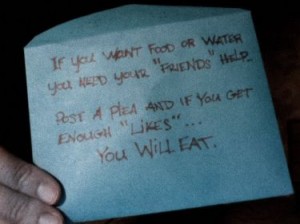We all know that social media, or web 2.0, is an important or even essential ingredient to marketers of the business world today. What makes social media so different from traditional advertisement though? SOCIAL of course! The interaction between the business and the fans through casual conversations, pictures and videos. It’s a chance to listen and monitor what your customers are saying and even better- to influence them in the right direction.
Recently, Intel and Toshiba partnered to create a campaign that included almost every
 aspect of social media. In July of 2011, they worked with D.J. Caruso, the director of Disturbia, and created a social film on Youtube, consisting of 8 episodes, called Inside.
aspect of social media. In July of 2011, they worked with D.J. Caruso, the director of Disturbia, and created a social film on Youtube, consisting of 8 episodes, called Inside.
They set up a story of a girl called Christina, played by Emmy Rossum, who wakes up trapped in a room with her laptop. What was her only choice of escape? Through the help and support of the fans on the Internet. Everyone could participate in influencing the plot of the story through Facebook posts and tweets. One lucky audience even had the chance to star alongside Emmy by Youtube auditions.
On Facebook, each character of the movie had their own scripted Facebook pages where the fans could interact with them on a personal level. Here is a clip of a fan’s posts:
![]() The film actually took the advice of this post in the next episode; an example of how the audience’s Facebook posts could ultimately change the storyline.
The film actually took the advice of this post in the next episode; an example of how the audience’s Facebook posts could ultimately change the storyline.
Another creative way to get more viewers was with the power of the ‘Like’. On one of the episodes, Christine showed her viewers a note written by her kidnapper.
 This steered lots of new viewers on board and pushed the current fans to spread the word. Smart eh?
This steered lots of new viewers on board and pushed the current fans to spread the word. Smart eh?
Here’s a video of all the audience interactions that took place during the campaign if you’re interested:
It is incredible to see so many different types of people from all around the world work together on this one project. This is what social media is all about. Connecting people who never would have had the chance to before and bonding them with similarities and interests
Now how much BUZZ did this create?
- It was watched over 50 millions times and counting
- There were 4 million interactions with the main character on Facebook
- Hundreds of stories on the press including comments from Cosmopolitan Magazine, The Washington Post and Good Morning America
And how does this all bring back to Intel and Toshiba?
The Toshiba laptop that Christina uses is one of the main characters of the film. It was the reliable and technologically advanced device that saved the character in the end.
Now my question to you is: Why haven’t I seen this kind of campaign in the health and beauty industry yet? It may not have to be as grand as this social film, but I have seen other smaller campaigns like “Away we happened” sponsored by AT&T. This size of campaign is absolutely feasible for companies like Lush and Lululemon. I’m interested to see what the future of social films would bring us when more companies decide to adopt this brilliant idea. It’s a happy family connecting the business and its fans through Facebook, Twitter, Youtube, and a whole lot of conversations.
Here is the full ‘Inside’ movie:

